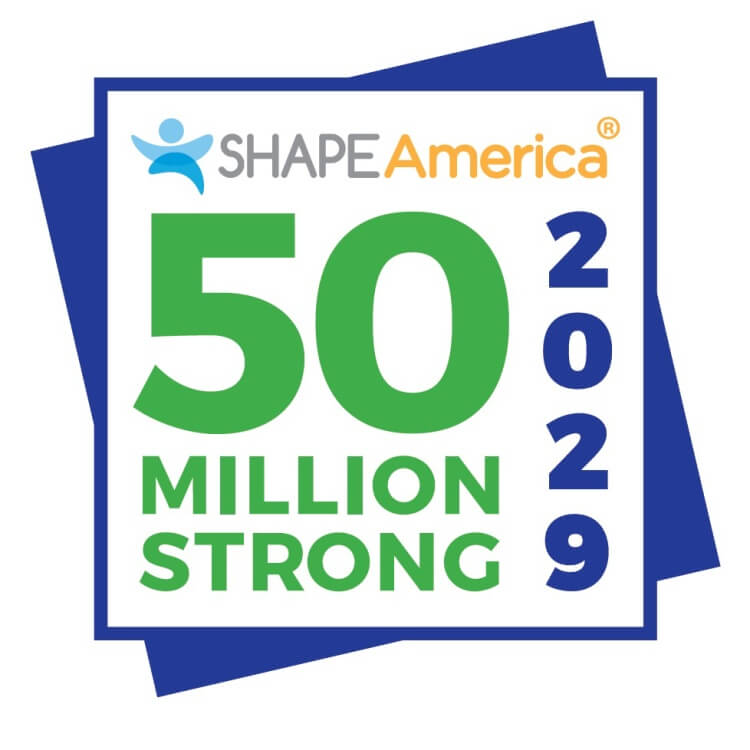First, let me introduce myself and justify why I might have anything worthwhile to say to the SHAPE America audience. Many years have passed since I was a teaching fellow at the University of Oregon in the same doctoral studies program as SHAPE America President, Steve Jefferies. For much of that time I’ve been ensconced in a liberal arts university, living the life of the university professor; happily teaching in the classroom, somewhat reluctantly serving in the college administration, and producing books with such esoteric titles as Contemporary Kinesiology and Health Ethics.

But it’s also true that in my dim and distant past, I received my teaching certification and experienced the life of teaching physical education. Given my world and worldview as a young teacher/coach back in the seventies in a comprehensive school in Oxfordshire, England, I’ve no doubt that public school PE teaching in the fast-paced world of contemporary America is very different. But I also suspect that some of the challenges and basic questions that I faced then and there are similar to issues you are encountering here and now. Similarly, although I have spent many years studying sport theory, I have also experienced the blood, sweat, and tears of coaching, both as the tennis coach at Wellesley College in the seventies and as the coach of the Women’s Soccer program at the College of William and Mary in the eighties. My point is that I have toiled in the trenches teaching students various physical activities and have had many years to reflect upon those experiences. So I was pleased when Steve asked me to share some thoughts and I’m hopeful that I can say something worthwhile to help shape SHAPE America.
Let’s take a journey (Destination: 50 million strong)
In his speech as candidate for President-Elect at the 2014 AAHPERD/SHAPE America Convention in St. Louis, Steve Jefferies suggested we should use the superb delivery system of a physical education teacher in every school to help us reach the goal of making “50 million strong,” meaning ensuring that the approximately 50 million young people in our schools are physically active and leading healthy lives. He identified a key ingredient to success in this venture as “a clear and unifying goal to strive for.” Because I share Steve’s concern for the future and have studied values intensively and extensively throughout my career, I plan to make this focus on a clear and unifying goal that we should strive for, the centerpiece of my essay.
I’ve always been something of a values-based policy wonk. My dissertation, leading to my first publication in Quest in 1979, was a study of alternative social constructions of reality in the gym; based on different ways of valuing the process and the product of human movement (that I labeled “technocentric” and “homocentric” ideologies). Most recently I envisioned the confluence of a strategic plan for the future (discussed in my 2005 NAKHE Delphine Hannah lecture) premised on and produced by values in action (the focus of my 2013 NAKHE Dudley Allen Sargent lecture). Based on the distance between these dates you might conclude I’ve not progressed very far! But I do think I’ve successfully sparked some thinking with my ideas about values, and maybe even said something applicable to everyday settings. Anyway, I hope that what I have to say here will resonate with questions you may have about your daily practice or at the very least provide food for thought.

Setting the goal for your journey
I’m convinced that goals should be based on intentional values. In fact, I can’t think of any goal that is not a reflection and enactment of a value-system, although we could all probably identify situations where underlying values are not made explicit and not clearly understood. Look no further than the current election season to see an array of political goals attacked on the basis of their implied values. While it’s tempting to dismiss this political posturing as irrelevant to your daily practice in the world of sport, health, and physical education, I suggest that it’s incumbent upon us to be as explicit and clear in intentionally espousing values as it is to the politician; in fact perhaps more so. Our political system does not always nurture action; candidates are elected but find themselves unable to effect change, particularly given the intransigence of party politics. You, however as a physical educator, are a change agent with extraordinary power to significantly affect the health, strength, and happiness of 50 million students, one young person at a time.
Intentionality, based in reflective analysis of what we value most, is the key to effectiveness. It’s too easy to take a recipe for success in our daily life that someone else might have found successful, to repeat it, but not really to consider what we value and hope to achieve. In contrast, I am advocating a values-based professional journey to the place where our philosophy about physical education intersects with the long-held (and sometimes unchallenged) practices of physical education and health. (If you have already arrived, you may read no further!).
Our challenge as teachers is to be authentic, to know what we value and to set goals premised on those values that will help us to create “50 million strong,” one student at a time. And let’s understand that this concept of “strong” should not be limiting. It extends beyond physical power and hours spent weight training. It also implies certitude (the inner strength of knowing what is right, why and how we should select a lifestyle leading to wellbeing), and fortitude (the inner strength and courage to forge ahead with a healthy active lifestyle when faced with trials and tribulations that might derail that course of action). To answer the question we face as we contemplate Steve’s call to action about how to inculcate strength in our students that will last a lifetime through our daily professional practice, I propose that we take a values-based journey. Despite the popular aphorism that the process is less about the destination than the journey, we still want to have a clear and unifying goal in order to avoid the danger of wandering aimlessly from place to place in search of our values’ platform.
Finding your Platform
As physical educators, developing a values-based curriculum starts with analyzing your own hierarchy of values and then synthesizing learning experiences that incorporate your primary values into your curriculum. The possible platforms are many: skill acquisition, competitive performance capability, health, exercise as medicine, fitness, recreation, play, and others. Although itâ’s possible to make connections between several of these platforms en route to our destination, the underlying values for each are distinct enough to require a different set of goals. Our challenge is to analyze the most important principles by asking what is the most important goal I want to achieve in my teaching and then to create a physical education and/or health delivery system specifically designed to achieve that purpose. For the sake of illustrating this process, let’s think about play, if only because it is rare that we seriously think seriously about play and because Plato, who is after all an iconic figure when we talk about values in Western civilization, suggested that Life must be lived as play.

Many sets of values could lead to play as a platform for goal setting. For example, one could make a case that play revolves around a particular value-system that at its core is patriotic. After all, what could be more American than the values of life, liberty, and the pursuit of happiness? The challenge for you if you decide you want to base your professional practice on life, liberty, and the pursuit of happiness is how to operationalize these goals. How can you transpose this triumvirate of constitutional values into a clear and unifying teaching goal of presenting physical education and health as play? Here’s an example.
Life is probably the most straightforward goal to incorporate into your programming insofar as we all have the basic desire to prolong and enhance the quality of life of our students by imparting skills and knowledge that will increase longevity and foster wellbeing. The challenge is how to present life skills in a playful manner. Dull exercises, rote memorization, and lectures on the dangers of obesity and the importance of sacrificing life’s pleasures now in the interest of health in the future, will seem more like work than play to young people. In contrast, the process of creatively exploring their environment, learning through their own experiences, and experimenting with their own unique play patterns and health habits aided by the guidance of a skilled instructor, might inspire the type of sustainable inner strength that will be needed throughout their lifespan (including those years when you are no longer available to direct their learning and lifestyle choices).
Liberty is a mainstay of play in that play provides both protection (freedom from) and possibility (freedom to). Play provides opportunities to get away from the stress and rigors of everyday existence. It includes a make-believe quality that allows students to fulfill their fantasies. To reach this goal of liberty, we could structure the learning of our younger students around self-discovery and optimal personal development of skills through thematic movement exploration. As students mature we might introduce the skills and knowledge of the sports they enjoy on an individual basis, encouraging them to adopt the role of star athlete or dancer as alternatives to the humdrum moments of their everyday lives. The challenge as a teacher is to structure your brief weekly encounters with your students in such a way that they can escape the negative elements of their existence and feel empowered to be all they can be. We can hope that if they learn through their encounters with us in the gym, that play means liberty because it is a freeing experience, they will seek out similar self-affirming play experiences throughout their lives.
Finally, play is premised on the pursuit of happiness. Happiness means different things to different people, but by structuring our curriculum around an array of intrinsically rewarding creative activities, students will be able to pursue happiness in their own unique ways. Based on this platform we could design a curriculum that would feature our principles at play, but we should first calculate the cost, in both financial and interpersonal political capital terms.
Taking this course of action is not without risk. Developing a play-based curriculum might break with the pedagogical traditions of your school and might bring you into conflict with those who value other approaches to health and physical education. Standing up for your principles, particularly when that might radically challenge the status quo, takes courage, conviction, and the strength to put your values in action. Obviously, it’s going to take strong teachers to provide the leadership necessary to make 50 million students strong!
Using a moral compass to guide you through your journey
Finding your platform is only just the beginning of this professional journey. We also need a moral compass to guide us every step of the way. Values, as they relate to health and human movement are increasingly becoming prioritized in society and in our educational institutions. In higher education, values are being increasingly emphasized in medical training and in sport, as we see a need for major reforms. But values do not suddenly emerge when students reach college age; they are learned throughout the spectrum of education and taught to children at every stage of moral maturity. Like it or not, we influence our students through the way we handle values in the classroom, gym, and playing field and in the way we model our own value system. Putting values first may be a reactive process where we react on a case-by-case ad hoc basis to ethical issues as they arise, or it may take the shape of a more intentionally structured proactive curriculum overhaul.
Higher education is changing to better accommodate values training, and in so doing it is introducing curricular innovations that might be helpful to you. For example, at the College of William and Mary we are working on a conceptual moral framework called Values In Action (VIA) designed to introduce the process of valuing health and human movement and to help students to develop their own moral compass. This process, which is described in depth in Health Ethics, incorporates ethical theory with situational and dispositional factors that modify the moral decisions we make and relates them to the dilemmas we and our students face on a daily basis. For program participants the VIA training approach is envisioned as a three part process: (1) taking a values inventory that can be adapted to the varied needs of the health and human movement field; (2) goal-setting based on the outcomes of the inventory; and (3) developing strategies for reaching those goals through curriculum, pedagogy, and personal practice.
Concepts such as ethical theory and values inventories, often neglected in the past, perhaps because they seemed tangential to physical education and health, are attracting attention as ethical issues become more and more relevant to their conduct. Today’s students are constantly facing ethical questions about how to play, both in athletic competition and the game of life. Scandals and abuses are well documented at all levels of sporting practice. Examples of excesses and abuse in the name of winning at all costs, personal profit, and dehumanizing technology at the peak of the lucrative sporting entertainment business pyramid, filter down through the media to our youth. If we are going to put values first in our professional practice, we need to think hard about our role in the pedagogical process.
Similarly, health is increasingly fraught with moral decisions. As our technological and scientific capabilities expand into every realm of preventive, proactive health and reactive medical health care, our students will find that the traditional questions about what options are available (what can I do?) are becoming less salient and pressing than their ethical choices (what should I do?). The responsibility of helping students to develop their own moral compasses, particularly during their formative years of early moral maturation, falls squarely on the shoulders of teachers. So how might this play out in a physical education and health classroom?
Returning to our example of adopting play as a platform for our physical education program, are we willing to make modifications that are designed to heighten moral sensitivity? Can we conceive of strategies that will increase emphasis upon values associated with playing, such as life (quality and longevity), liberty (freedom from daily pressures and freedom to reach potential) and the pursuit of happiness (experiencing the joy of living fully)? Similarly when teaching students how to play a game, will we focus on virtues such as fairness, respect, integrity, and responsibility, in addition to gameplay and strategies for winning?

Are we there yet?
I suspect that many of you are familiar with that whining question from the back seat near the end of a long journey. In this case, I think it is fair to answer that our values-based journey through the landscape of health and physical education is only just beginning. In his St. Louis address, Steve Jefferies suggested, “SHAPE America and the professions we represent need to be prepared to make some big, brave, and in all likelihood bold decisions.” One bold step would be to put values first. He encouraged his audience to “not underestimate our value to other health-promoting groups or our potential to change the country.” My enjoinder to this admirable agenda is to not underestimate our values as we seek to change the country by making 50 million youths morally strong, one student’s values at a time.

